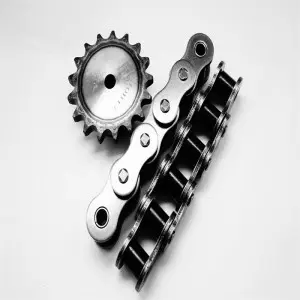(1) The main difference between the steel materials used for chain parts at home and abroad is in the inner and outer chain plates. The performance of the chain plate requires high tensile strength and certain toughness. In China, 40Mn and 45Mn are generally used for manufacturing, and 35 steel is rarely used. The chemical composition of 40Mn and 45Mn steel plates is wider than that of foreign S35C and SAEl035 steels, and there is 1.5% to 2.5% thickness decarburization on the surface. Therefore, the chain plate often suffers from brittle fracture after quenching and sufficient tempering.
During the hardness test, the surface hardness of the chain plate after quenching is low (less than 40HRC). If a certain thickness of the surface layer is worn away, the hardness can reach more than 50HRC, which will seriously affect the minimum tensile load of the chain.
(2) Foreign manufacturers generally use S35C and SAEl035, and use more advanced continuous mesh belt carburizing furnaces. During the heat treatment, a protective atmosphere is used for recarburization treatment. In addition, strict on-site process control is implemented, so chain plates rarely occur. After quenching and tempering, brittle fracture or low surface hardness occurs.
Metallographic observation shows that there is a large amount of fine needle-like martensite structure (about 15-30um) on the surface of the chain plate after quenching, while the core is strip-like martensite structure. Under the condition of the same chain plate thickness, the minimum tensile load after tempering is larger than that of domestic products. In foreign countries, 1.5mm thick plates are generally used and the required tensile force is >18 kN, while domestic chains generally use 1.6-1.7mm thick plates and the required tensile force is >17.8 kN.
(3) Due to the continuous improvement of the requirements for motorcycle chain parts, domestic and foreign manufacturers continue to improve the steel used for pins, sleeves and rollers. The minimum tensile load and especially the wear resistance of the chain are related to the steel. After domestic and foreign manufacturers recently selected 20CrMnTiH steel as the pin material instead of 20CrMnMo, the chain tensile load increased by 13% to 18%, and foreign manufacturers used SAE8620 steel as the pin and sleeve material. This is also related to this. Practice has shown that only by improving the fit gap between the pin and the sleeve, improving the heat treatment process and lubrication, can the wear resistance and tensile load of the chain be greatly improved.
(4) In motorcycle chain parts, the inner link plate and the sleeve, the outer link plate and the pin are all fixed together with an interference fit, while the pin and the sleeve are a clearance fit. The fit between chain parts has a great influence on the wear resistance and minimum tensile load of the chain. According to the different use occasions and damage loads of the chain, it is divided into three levels: A, B and C. Class A is used for heavy-duty, high-speed and important transmission; Class B is used for general transmission; Class C is used for ordinary gear shifting. Therefore, the coordination requirements between Class A chain parts are stricter.
Post time: Sep-08-2023

